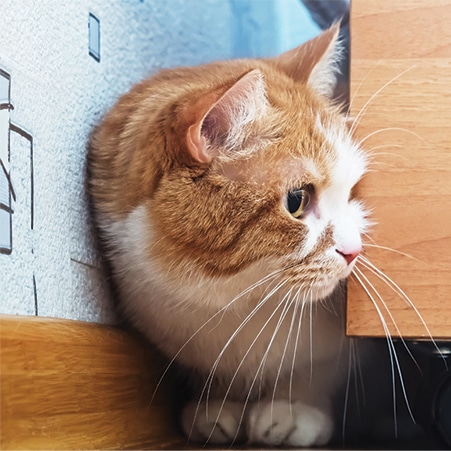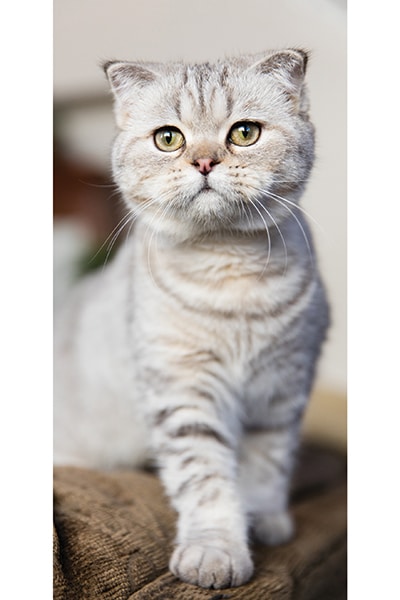Don’t Be A Scaredy-Cat
The post Don’t Be A Scaredy-Cat by Ellyce Rothrock appeared first on Catster. Copying over entire articles infringes on copyright laws. You may not be aware of it, but all of these articles were assigned, contracted and paid for, so they aren't considered public domain. However, we appreciate that you like the article and would love it if you continued sharing just the first paragraph of an article, then linking out to the rest of the piece on Catster.com.
We often think of cats as contented little furballs, spending the lion’s share of their days quietly snoozing in warm slivers of sunshine in between treats, meals and the occasional ear scratch. What in their seemingly pampered lives could possibly cause them anxiety?
The truth is that many psychological, physical and environmental factors can cause feline anxiety. And while occasional stress is normal for any cat, constant or severe anxiety can be a serious problem. How does a cat signal that she is feeling anxious, and how can pet parents help soothe their feline companions? Taking time to observe and understand feline behavior can go a long way toward managing the situation.
“Cats are creatures of habit, and it’s important to pay attention to any change in behavior that could be a potential red flag indicating a behavior problem,” says Pam Johnson-Bennett, best-selling author, feline behavior and training expert, and founder and former chair of the International Association of Animal Behavior Consultants’ Cat Division.
Cats can experience two kinds of anxiety — acute, which is situationally produced, and chronic, ongoing anxiety, according to Nicholas H. Dodman, BVMS, DACVA, DACVB, professor emeritus of animal behavior and behavioral pharmacology at the Cummings School of Veterinary Medicine at Tufts University and author of The Cat Who Cried for Help and other best-selling animal behavior books. “Some humans might be very anxious if they must speak in public, and there are other people who are just anxious all the time,” Dr. Dodman says. “Cats are like that, too.”
Anxiety and fear, while closely related, are not equal, according to Dr. Dodman. “There are cats who are perfectly happy when the door is shut and they’re spending time with mom and dad, but if something happens — a party, a few people come to visit — the cat hides under the bed, waiting for the party to disperse or for people to leave. You could call that fear — not anxiety,” he says.
Know the signs
Commonly cited characteristics of feline anxiety may include “clingy” behavior, aggression, eye contact avoidance, distance-increasing body postures, excessive grooming, feigning sleep, hiding, lack of interest in play, lack of interest or increased interest in food, litter box avoidance, startle responses and vocalization.
However, according to Dr. Dodman, aggressive behavior may be rooted in fear and not anxiety.
“If a cat is imposed upon by someone she’s afraid of, and that person doesn’t respect her space, tries to pick her up and the cat bites, that’s a cat that’s frightened.”
Similarly, vocalization might not necessarily signal anxiety, he says. “She could want to be fed and is vocalizing more out of impatience or anger,” he says. “Also, cats with Alzheimer’s vocalize late at night.”
Litter box issues don’t always signal anxiety, either.

Knowing what signs of fear your cat shows could help determine the causes of such fears. Photography by: ©Basnik | Getty Images
“There are two types of litter box problems,” Dr. Dodman says. “One is that the cat simply doesn’t like the facilities provided — too few boxes, litter is too deep or not deep enough, the cat doesn’t like the scent, etc. In those situations, cats will urinate on a carpet in a corner.
“However, an anxious cat may start marking and spraying in the house,” he says.
“Cats with anxiety-related issues involving territory and other cats will mark the baseboard, the drapes or the windowsill — right at the place where the anxiety is happening”, Dr. Dodman continues. “This includes people, new babies, cats in and outside the house and whatever else induces a state of chronic anxiety, which then manifests as urine marking. A cat may get upset that her favorite person left her alone and mark the bed or that person’s clothes. Cats also will urinate on things of people they don’t like, stamping them as their own.”
Other signs can be so subtle that owners can miss them. “People either fail to recognize the signs or they just think there’s nothing that can be done — it’s just a cat. It’s what they do,” Dr. Dodman says.
These more subtle signals include dilated pupils, facial cues and posturing (ears back and low body posture), avoidance, hypervigilance and wool sucking.
Determine the cause
It’s often easy for us humans to identify large stress triggers in our feline companions because we can easily identify with them — such as past traumatic experience(s) like abuse or injury, a new cat (or human) in the household or the death of a companion cat (or human).
However, chronic feline stress can be the result of easily missed circumstances like a too-dense cat environment, unappealing litter box conditions, a lack of resource availability, inconsistent or counterproductive training, not enough personal space and an inconsistent meal schedule, according to Pam.
Further, ongoing multi-cat tension, long owner absences, an inability to engage in normal behavior, such as scratching if no effective scratching post is available, and the lack of consistent playtime and environmental enrichment can lead to anxiety.
“It’s important that cat owners understand what normal cat behaviors are so they can provide an environment that allows cats to engage in those behaviors,” Pam says. “All too often, new kitten/cat owners don’t learn enough about what cats need.”
More commonly, says Dr. Dodman, a cat becomes anxious due to a lack of proper socialization and exposure to various people, animals and situations during the critical 2- to 7-week-old period in a kitten’s development.
Genetics can sometimes play a role, particularly in high-strung breeds like Siamese, he adds.
Soothe the stress
The first step in helping a cat with anxiety is to figure out the cause, if possible, so you can create an effective behavior plan, Pam says.
“The cause could be big or it could be very small and easily overlooked, but it’s important to work on identifying it,” she says. “Next, provide the cat with choice. Having choice is a big stress reliever — the choice of whether to hide or be in the open, the choice of whether to interact or sit on the sidelines, the choice of whether to be held or not, etc.”
Another important aspect of dealing with anxiety is to “make life fun again,” Pam says.
“Very often, the anxious cat doesn’t get to enjoy playtime, being social, affection or even napping in peace,” she says. “That’s where environmental enrichment, playtime and trust-building come into play. Finally, find a language that you and the cat can share in order to help her see the benefits of taking small steps toward progress. This is where I often use clicker training.”
Owners also should consider timing of all things, Dr. Dodman says.

Find the best way for your cat to play and unwind! Photography by: ©GabrielPevide | Getty Images
“Don’t expose cats to the full brunt of life, such as during busy holidays, or forcing a quick introduction to a new house, other animals and other people,” he says. “Create a calm, controlled situation that provides the cat with a room of her own, food, water, a litter box, a view and enrichment.”
Safe areas or hiding places, particularly if there are issues between or among cats, slow introductions, routines, toys and quality time that includes play, exercise and affection are all great ways to manage feline anxiety and keep it at bay, Dr. Dodman says.
Natural supplements, such as Anxitane, which contains the amino acid L-theanine, and valerian root, both of which can cause a calming effect, may be helpful, says Dr. Dodman, adding that cannabidiol (CBD) also offers great promise and potential but requires further research.
Both experts agree that before embarking on any treatment modality, always check first with your cat’s veterinary health or behavior professional.
Put Behavior Modification to Work
Behavior modification can address, manage and often resolve feline anxiety. Here are five techniques recommended by Pam Johnson-Bennett, feline behavior and training expert, and Nicholas H. Dodman, BVMS, DACVA, DACVB.

Resolving your cats anxiety can require many different methods. Photography by: ©Erica Danger | ericadanger.com
- Counterconditioning/Desensitization. Counterconditioning aims to reduce unwanted behavior by teaching the cat to replace it with another, more favorable, behavior. Desensitization gradually teaches a cat to tolerate a situation by carefully exposing her to the situation in small steps. Both are useful in managing anxiety, especially when the trigger is something that will remain, in some form, in the environment (vacuum cleaner, carrier, travel).
- Habituation. The ending of or decrease in a response to a stimulus that results from repeated or prolonged exposure to that stimulus.
“It’s like the scarecrow effect,” says Dr. Dodman, citing an example of simply sitting in a closed room, watching TV, with a newly introduced fearful/anxious cat hiding under the sofa. “The cat learns that nothing bad is going to go down, and she slowly emerges more and more, and she calms to the owner’s presence. It’s an onionskin approach — peeling away the layers”. - Second-order reinforcers. Signals that can be used at a distance to let the cat know that a reward is coming. Commonly used second-order reinforcers are words such as “good kitty,” clickers and whistles. “Second-order reinforcers are very effective and easy for owners to use and can be a big help in building trust,” Pam says. “Clicker training helps the cat learn and take baby steps, but it also works on developing and strengthening the bond between cat and owner.”
- Shaping. Works through gradual approximations and allows the cat to be rewarded at first for any behavior that resembles the desired end result. According to Pam, this valuable technique that provides a roadmap toward the target behavior but rewards the cat for small steps works well for owners because it makes training less overwhelming.
- Pharmacological treatment. Prescribed medications, such as Buspar (buspirone) or Prozac, can help facilitate a behavioral program or work solely, Dr. Dodman says.
“Buspar is a very targeted, anxio-selective drug that builds confidence and delivers a very effective anti-anxiety effect,” he says. “Prozac can shut down anxiety and related urine marking behavior.”
About the author:
Ellyce Rothrock spent half her life with Flea, a Maine Coon who lived to be 21 and is missed every single day. She’s currently seeking a feline friend to manage Fritz and Mina, her German Shepherd rescues. She’s lucky enough to live her passion for pets as a 25-year member of the pet media industry.
Learn more about cat anxiety on catster.com:
The post Don’t Be A Scaredy-Cat by Ellyce Rothrock appeared first on Catster. Copying over entire articles infringes on copyright laws. You may not be aware of it, but all of these articles were assigned, contracted and paid for, so they aren't considered public domain. However, we appreciate that you like the article and would love it if you continued sharing just the first paragraph of an article, then linking out to the rest of the piece on Catster.com.
from Catster https://ift.tt/2ZixBc0
Comments
Post a Comment